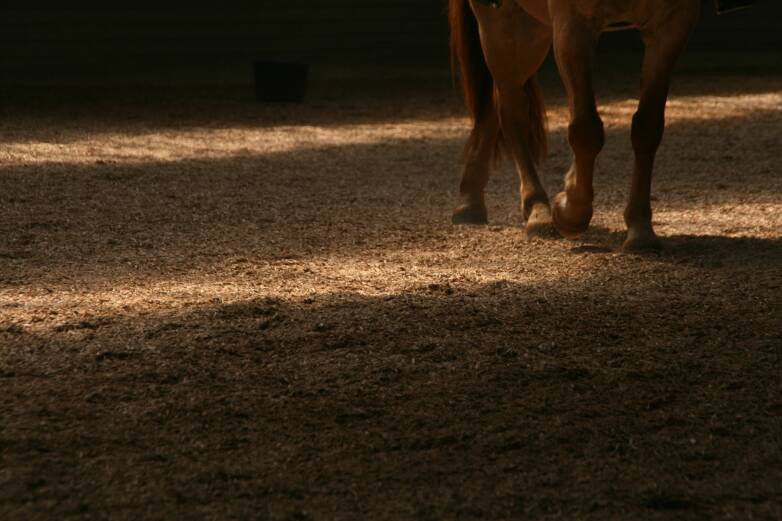About Lucile Bump
Lucile Bump is a certified Senior Instructor (Level IV) in centered riding. She has worked closely with Sally Swift, who initially described the fundamental principles of Centered Riding. Therefore, Lucile Bump has a deep understanding of these principles, and she also has experience in disciplines such as western, dressage, and jumping. Regardless of the discipline, Lucile Bump has always worked to promote the collaboration between horse and rider.
She is 81 years old and has been riding since she was 10. Her equestrian career began in Vermont, USA, where she is still located today, at Southmoving Stables. Furthermore, she continues to travel worldwide to conduct courses and teach centered riding.
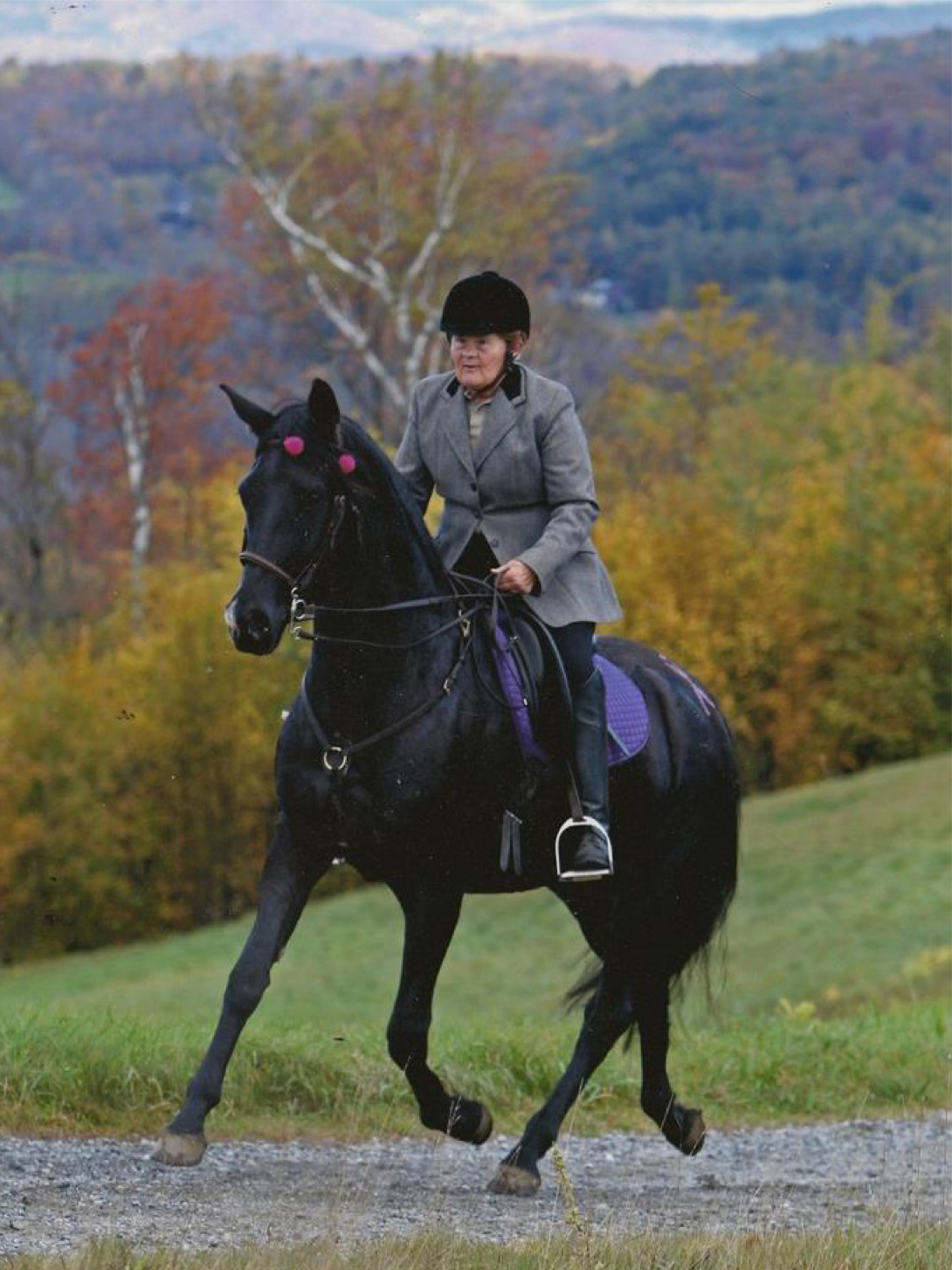
Legs and feet: Take one foot out of the stirrup and raise the leg up, sliding it slowly down and back. Rotate the knee back into place along the saddle and stretch the heel towards the ground, feeling a stretch in the inner thigh. Count to five and release the stretch. Then, stretch the toes up and place the foot back in the stirrup, achieving a flat foot position. The stretch should ideally make your toes end up below your knees when you're finished. Repeat the same process on both legs and finally, check if your knee has the flexibility to follow the horse's movements.
Shoulder and hands: When you have the above in place, your hands should be positioned just in front of your ribcage, and your elbows can be heavy, creating a smooth contact with the bit. During riding, your hands should remain in the same soft position and have a light contact, neither pulling forward nor backward.
The above should help you achieve correct alignment - a position that is soft and allows you to easily follow the horse's movements and use your body to guide the horse. It is important that we learn all the basics.
We need to know how we sit and how our movements, balance, and center affect our horse. When there is an exercise that we cannot perform from the horse's back, it may be appropriate to look at ourselves. For example, is it our imbalances and lack of balance that unnecessarily make it difficult for the horse to perform the exercise we ask of it.
With the theory and exercises that centered riding offers, we as riders can become aware of these possible imbalances. Working on our bodies should help us become more balanced and relaxed riders - thus allowing our horses to work more balanced and relaxed.
Center: Place a hand on your back and engage your core muscles to stabilize yourself and straighten your back by activating your center. This will bring your center back and down while lifting your pelvis.
Neck and head: Look down and hold the stretch for five seconds. You should feel the stretch between your shoulder blades. Straighten up and possibly look up, aligning your head high naturally in line with your neck. When riding, you can have someone walk you on your horse, allowing you to try releasing the reins, placing your hands on top of your helmet, and pushing your head up to ensure proper alignment in the saddle.
Shoulders: Roll your shoulders back - one at a time. When you roll one shoulder, you should feel your weight shifting to the opposite seat bone. You can also perform this exercise while riding, as you need to be able to rotate your shoulder when turning your horse.
Here are some tips on how you can correct yourself to achieve optimal posture, body part by body part. This way, you may be able to correct yourself even without an instructor by your side, ensuring that you sit accurately in the saddle. It will provide the best conditions for you and your horse for a good ride and optimal learning.
Perform a self-check
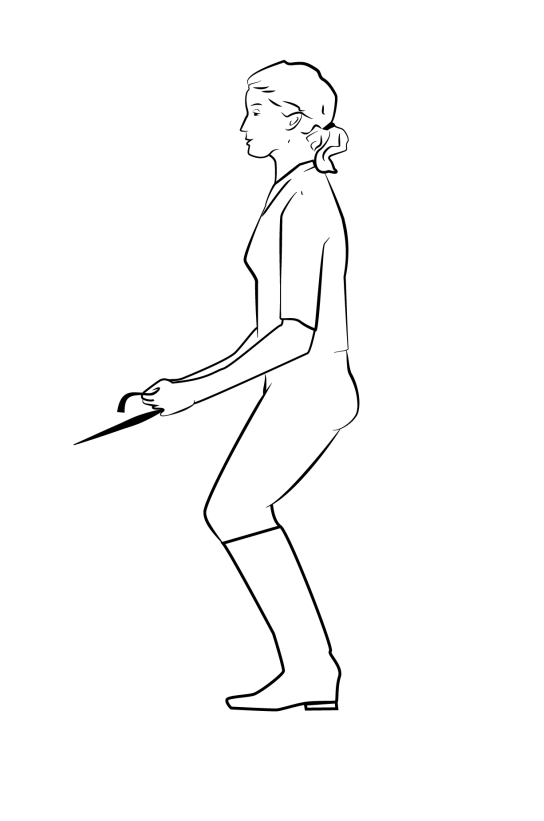
Building blocks: Imagine your body as building blocks. All of these blocks must be balanced correctly on top of each other, so you don't tip to one side or the other.

Centering: To ride Centered, we need to know where our center is. You can find your center by placing one hand on your abdomen and another on the lower back and activating your core muscles. If your center remains stable, your center of gravity will lower, and you will sit stably in the saddle with an upright pelvis and a relaxed back. This way, you can use your center for everything from stopping to turning.

Soft eyes: Our eyes are capable of perceiving what is happening around us when we use our peripheral vision. However, when we focus on one point with our eyes, our field of vision narrows, and we fail to register what is happening further around. Soft eyes, on the other hand, possess a natural mobility and awareness of our surroundings.
Breathing: Breathing should involve the entire body. Proper breathing engages the diaphragm and helps us relax and improve our balance. With deep breathing, we can imagine that we are breathing through our entire body - from head to toe. When we hold our breath, we tense up, which often transfers to the horse - something we should avoid.

Fundamentally, centered riding is about riders knowing - and learning - how to use their bodies correctly, so that we can teach our horses to use their bodies balanced and correctly.
Centered Riding is not perceived as a specific equestrian discipline, like dressage, for example. Instead, it consists of techniques and tools that can be used across all disciplines, allowing riders to become more aware of their bodies and how they function. These techniques were developed by Sally Swift (1913-2009), and in 1985 she published the book "Centered Riding", which has since been translated to 15 languages.
In centered riding the focus, is on both human and equine anatomy, but primarily starting with the rider, who must center and balance themselves. The principles of Centered Riding are inspired by oriental martial arts, the Alexander Technique (a training method involving neurophysiology, gravity, and consciousness), biomechanics and sports psychology.
If you want to implement the principles of centered riding it is important to have a basic understanding of your own body, according to Lucile Bump.
"You need to know how your own body works before you can teach it to the horse. How can you teach your horse a movement that you cannot do yourself?" says Lucile.
Therefore, Lucile Bump utilizes many exercises without the horse, which riders can practice. Afterwards, many of these exercises can be tested and applied while riding. As Lucile Bump's instruction often includes exercises that make riders aware of how their bodies function, this can help us as riders develop greater consciousness and control. It requires us to work on everything from breathing to our position in the saddle and to actively utilize all of this in our riding.
"Centered Riding teaches the rider how to perform the exercise, so they can teach it to the horse. What you do, the horse does too."
By Cæcilie Kallehave Jensen
Photos private // Illustrations is made by Benedikte Hansen with inspiartion form the book "Centered Riding" by Sally Swift.
Want to try Centered Riding?

About Lucile Bump
Lucile Bump is a certified Senior Instructor (Level IV) in centered riding. She has worked closely with Sally Swift, who initially described the fundamental principles of Centered Riding. Therefore, Lucile Bump has a deep understanding of these principles, and she also has experience in disciplines such as western, dressage, and jumping. Regardless of the discipline, Lucile Bump has always worked to promote the collaboration between horse and rider.
She is 81 years old and has been riding since she was 10. Her equestrian career began in Vermont, USA, where she is still located today, at Southmoving Stables. Furthermore, she continues to travel worldwide to conduct courses and teach centered riding.

Legs and feet: Take one foot out of the stirrup and raise the leg up, sliding it slowly down and back. Rotate the knee back into place along the saddle and stretch the heel towards the ground, feeling a stretch in the inner thigh. Count to five and release the stretch. Then, stretch the toes up and place the foot back in the stirrup, achieving a flat foot position. The stretch should ideally make your toes end up below your knees when you're finished. Repeat the same process on both legs and finally, check if your knee has the flexibility to follow the horse's movements.
Shoulder and hands: When you have the above in place, your hands should be positioned just in front of your ribcage, and your elbows can be heavy, creating a smooth contact with the bit. During riding, your hands should remain in the same soft position and have a light contact, neither pulling forward nor backward.
The above should help you achieve correct alignment - a position that is soft and allows you to easily follow the horse's movements and use your body to guide the horse. It is important that we learn all the basics.
We need to know how we sit and how our movements, balance, and center affect our horse. When there is an exercise that we cannot perform from the horse's back, it may be appropriate to look at ourselves. For example, is it our imbalances and lack of balance that unnecessarily make it difficult for the horse to perform the exercise we ask of it.
With the theory and exercises that centered riding offers, we as riders can become aware of these possible imbalances. Working on our bodies should help us become more balanced and relaxed riders - thus allowing our horses to work more balanced and relaxed.
Center: Place a hand on your back and engage your core muscles to stabilize yourself and straighten your back by activating your center. This will bring your center back and down while lifting your pelvis.
Neck and head: Look down and hold the stretch for five seconds. You should feel the stretch between your shoulder blades. Straighten up and possibly look up, aligning your head high naturally in line with your neck. When riding, you can have someone walk you on your horse, allowing you to try releasing the reins, placing your hands on top of your helmet, and pushing your head up to ensure proper alignment in the saddle.
Shoulders: Roll your shoulders back - one at a time. When you roll one shoulder, you should feel your weight shifting to the opposite seat bone. You can also perform this exercise while riding, as you need to be able to rotate your shoulder when turning your horse.
Here are some tips on how you can correct yourself to achieve optimal posture, body part by body part. This way, you may be able to correct yourself even without an instructor by your side, ensuring that you sit accurately in the saddle. It will provide the best conditions for you and your horse for a good ride and optimal learning.


Building blocks: Imagine your body as building blocks. All of these blocks must be balanced correctly on top of each other, so you don't tip to one side or the other.

Centering: To ride Centered, we need to know where our center is. You can find your center by placing one hand on your abdomen and another on the lower back and activating your core muscles. If your center remains stable, your center of gravity will lower, and you will sit stably in the saddle with an upright pelvis and a relaxed back. This way, you can use your center for everything from stopping to turning.
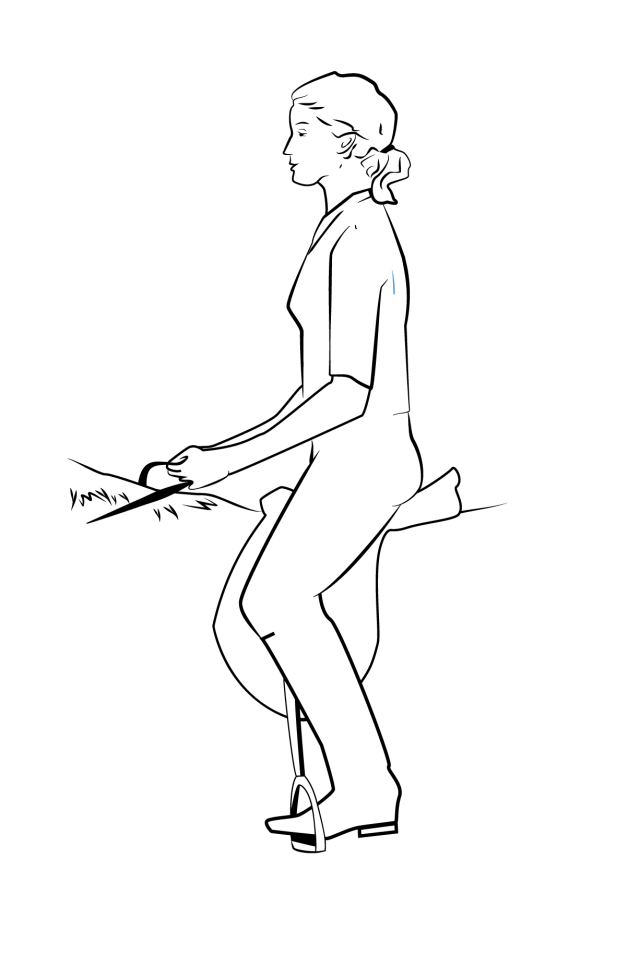
Soft eyes: Our eyes are capable of perceiving what is happening around us when we use our peripheral vision. However, when we focus on one point with our eyes, our field of vision narrows, and we fail to register what is happening further around. Soft eyes, on the other hand, possess a natural mobility and awareness of our surroundings.
Breathing: Breathing should involve the entire body. Proper breathing engages the diaphragm and helps us relax and improve our balance. With deep breathing, we can imagine that we are breathing through our entire body - from head to toe. When we hold our breath, we tense up, which often transfers to the horse - something we should avoid.
Perform a self-check
Fundamentally, centered riding is about riders knowing - and learning - how to use their bodies correctly, so that we can teach our horses to use their bodies balanced and correctly.
Centered Riding is not perceived as a specific equestrian discipline, like dressage, for example. Instead, it consists of techniques and tools that can be used across all disciplines, allowing riders to become more aware of their bodies and how they function. These techniques were developed by Sally Swift (1913-2009), and in 1985 she published the book "Centered Riding", which has since been translated to 15 languages.
In centered riding the focus, is on both human and equine anatomy, but primarily starting with the rider, who must center and balance themselves. The principles of Centered Riding are inspired by oriental martial arts, the Alexander Technique (a training method involving neurophysiology, gravity, and consciousness), biomechanics and sports psychology.
If you want to implement the principles of centered riding it is important to have a basic understanding of your own body, according to Lucile Bump.
"You need to know how your own body works before you can teach it to the horse. How can you teach your horse a movement that you cannot do yourself?" says Lucile.
Therefore, Lucile Bump utilizes many exercises without the horse, which riders can practice. Afterwards, many of these exercises can be tested and applied while riding. As Lucile Bump's instruction often includes exercises that make riders aware of how their bodies function, this can help us as riders develop greater consciousness and control. It requires us to work on everything from breathing to our position in the saddle and to actively utilize all of this in our riding.
"Centered Riding teaches the rider how to perform the exercise, so they can teach it to the horse. What you do, the horse does too."
By Cæcilie Kallehave Jensen // Photos private // Illustrations is made by Benedikte Hansen with inspiartion form the book "Centered Riding" by Sally Swift.
Want to try Centered Riding?
